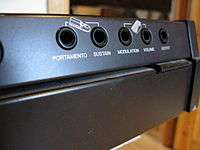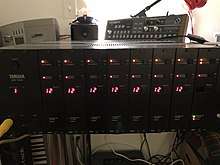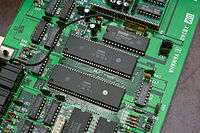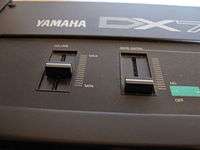Yamaha DX7
| Yamaha DX7 | |
|---|---|
|
| |
| Manufacturer | Yamaha |
| Dates | 1983–1989 |
| Price |
$1,995 US £1,495 GBP ¥248,000 JPY |
| Technical specifications | |
| Polyphony | 16-voice |
| Timbrality |
Monotimbral Bi-timbral (DX7 II) |
| Oscillator | 6 sine wave operators per voice, 32 algorithms[1] |
| Synthesis type |
Digital linear frequency modulation / Additive synthesis (alg. #32) |
| Filter | none |
| Attenuator | 1 pitch envelope & 6 amplitude generators per voice |
| Aftertouch expression | Yes (channel) |
| Velocity expression | Yes |
| Storage memory | 32 patches in RAM (battery backup); front panel ROM/RAM cartridge port |
| Effects | none |
| Hardware |
YM21280 (OPS) operator chip YM21290 (EGS) envelope generator |
| Input/output | |
| Keyboard |
61-note with velocity and aftertouch sensitivity |
| Left-hand control | pitch-bend and modulation wheels |
| External control | MIDI in/out/thru, input for foot controller x2, input for foot switch x2, input for optional breath controller |
The Yamaha DX7 is an FM synthesis-based digital synthesizer and electronic keyboard manufactured by the Yamaha Corporation from 1983 to 1989. It was the first commercially successful digital synthesizer.[2][3][4] The DX7 was the moderately priced model of the DX series keyboard synthesizers that included the larger and more elaborate DX1 and DX5; the feature-reduced DX9; and the smaller and not directly compatible DX100 (and its full sized keys version DX27), DX11, and DX21. Over 200,000 of the original DX7 were made,[4][5][6] and it remains one of the best-selling synthesizers of all time.[3][7][note 1] The DX7 was MIDI-compatible, which meant that it could be connected to other MIDI-compatible synth modules, drum machines, audio sequencers and computers.
Its distinctive sound can be heard on many recordings, especially pop music and dance music from the 1980s. Its preset sounds were particularly popular due to the difficulty of FM synthesis programming combined with the immediacy of the stock (preset) DX7 sounds, meaning that players tended to perform and record with the sounds they had at their fingertips. These stock sounds ultimately proliferated to the point that they were regarded as clichéd by the end of the 1980s.
Synthesis engine
Tone generation in the DX7 is based on frequency modulation synthesis, which was developed based upon research by/licensed from John Chowning at Stanford University.[8] This uses multiple sine wave oscillators, which can modulate each other in various configurations offered as 32 "algorithms", thus generating a wide variety of possible harmonic and inharmonic spectra. The DX7 was known for the precision and flexibility of its bright, digital sounds, which could be clearer and less linear than those of the subtractive analog synthesizers that preceded it.
The DX7 is well known for its emulation of percussive instruments, such as electric piano, bells, and other "struck" and "plucked" sounds which emphasize complex attack transients, which most analog synthesizers of the time could not produce. Phase modulation as used in this and later synthesisers is capable of generating a wide range of both imitative (like acoustic instruments, such as flute, violin, etc.) and purely synthetic, artificially-created sounds.
Programming
The DX7's voices (synthesizer sounds) can be programmed by the user, and stored into a 32-voice RAM internal memory, or corresponding 32-voice DX7 RAM cartridge inserted into a port on the front of the unit. Pre-programmed ROM cartridges could also be inserted, and the original DX7 shipped with two of these cartridges with two banks of 32 voices each, for a total of 128 voices available. Several computer applications were available for various operating systems (Atari, Mac OS, and Windows) that could enable a user to load different presets into the keyboard from a computer via MIDI; most computer-based MIDI recording software could also load to and save from the DX7.
There are a number of challengers for users wishing to programming the instrument. One issue is understanding FM synthesis theory. Another challenge is that Yamaha's DX "synth envelopes" is very different to the Attack, Decay, Sustain and Release (ADSR envelope) methods used to create sounds in other synths. Further, the instrument has a large number voice parameters. This is exacerbated by the DX7 requiring the manual entry of numbers for parameter values, rather than the simple turning of a knob.[9] Manufacturers including Jellinghaus and DTronics have created external control units with numerous knobs for easier setting of voice parameters.[10]
Due to these issues many musicians did not get far with programming the instrument; instead using Yamaha's factory preset voices.[11] A few musicians skilled at programming the DX7 found employment creating DX7 sounds for other bands, creating the "synthesizer programmer" occupation.[12]
Breath controller
The Yamaha DX7 came with a minijack connection for an optional breath controller, which sensed the air pressure inside the player's mouth and sent an analog output voltage to the DX7. The Yamaha BC1 breath controller, first developed for the Yamaha CS01 analog synth, but released in 1983 alongside the DX7, was gripped by the teeth of the player while the later BC2 and BC3 were supported at mouth level by a headset. With one of these, the player could use breath pressure to modulate vibrato, tremolo, dynamics (loudness or softness), harmonic "brilliance" or any other programmable value in the DX7.
The breath controller allowed the DX7 to be used to produce sounds similar to a wind instrument but with a piano keyboard for note selection. This could enable a synthesizer player to produce a more vocal-like performance of a melody, as it overcame one of the limitations of keyboard controllers, namely that the note is only triggered, and then either decays (as with a piano sound), or is sustained at the same volume (with a pipe organ sound). In contrast, with a breath controller, a synthesizer player could imitate a singer or a flute player's performance of a melody, swelling notes with crescendos.
Many of the preset Yamaha voices allowed for breath-controlled modulation, and such modulation could be programmed into any other voice. However, pop musicians performing on stage did not usually want to put a breath controller in their mouth, for visual reasons.[13] Yamaha also produced the WX series of dedicated wind controllers which emulated familiar wind instruments.
MIDI

The DX7 includes MIDI ports, so it can be plugged into external MIDI-compatible devices, such as synth modules or electronic drum machines. However, it was released shortly before the specification was completed, and MIDI was added late in its development. Thus, its MIDI implementation is quite modest; It only transmits information on MIDI channel 1 and, although it can be set to receive information on any one of the sixteen MIDI channels, it lacks the Omni feature of the MIDI standard that enabled later MIDI-equipped instruments, including ones by Yamaha, to receive on any of the 16 MIDI channels simultaneously.
Additionally, the maximum MIDI velocity value that the DX7 will transmit is limited to approximately 109 (of the maximal 127 defined by the standard). The DX7 will, however, respond to the full range of velocity values when sent from an outside MIDI source. This means that when using the DX7 as a MIDI controller to play external sound modules, the patches on these modules will have to be adjusted to be more sensitive to velocity. It also means that when playing the DX7's own sounds using an external MIDI controller or sequencer, the velocity values will have to be rescaled before input to the DX7, or the DX7 patches would have to be adjusted to be less sensitive to velocity.
Other jacks

At the rear of the DX7 is a small patch bay providing various input and output jacks. These include two jacks for a piano damper pedal-style momentary switch pedal (one for portamento, an effect that makes one note "glide" up or down in pitch to the next note, and a second jack for sustain, which holds any notes that the performer was pressing at the time she/he depresses the sustain pedal); two expression pedal jacks for modulation and volume (loudness and softness); and an output jack, which can be connected to a keyboard amplifier and loudspeaker, PA system or sound recording system. All of the jacks on the patch bay are standard 1/4" jacks. The external pedals must be purchased separately. For the output jack, the performer needs a standard 1/4" patch cord. To connect the DX7 to an audio console (mixing board), a DI unit may be needed to convert the signal to a level that is appropriate for mixers.
Variants
Upgrades
Yamaha released an updated ROM titled the Special Edition ROM (SER) that added oft-missed features such as the ability to choose the output MIDI channel (rather than having it preset just to channel 1), the ability to store function data (settings for pitch bend, portamento modulation, etc.) per-voice rather than just globally as in the original, and other frequently desired enhancements. Moreover, third-party upgrades for the DX7 flourished in the 1980s, most based upon upgrading the firmware albeit with a wider range of features than Yamaha's official SER. These included SuperMax and the most famous, Grey Matter Response's E! expansion board, which added increased patch memory and a vastly improved MIDI implementation to the original DX7.
Modules

The TX7 and the TF1 are synth modules, which are keyboardless versions of the original DX7, both of which are exactly compatible with original DX7 patches and produce sound in exactly the same way as the DX7. Since the TX7 and the TF1 do not have a MIDI controller keyboard or other MIDI controller as part of their construction, they must be connected via a MIDI cable to another MIDI-compatible controller (e.g., a MIDI-capable stage piano, a music sequencer, or another MIDI-capable synth in order to be used.

The TX7 is in a desktop case with a slanted front,[14] which was not designed to be rack mounted, but to sit on a tabletop or other flat surface. The TF1 has a small vertical form factor, designed to be inserted into a special chassis, called the Yamaha MIDI Rack Frame (MFR), which could accommodate up to 8 TF1s. This chassis was sold fully populated with 8 TF1s as the TX816. A reduced version with just two TF1s was sold as the TX216, and additional TF1s could be purchased separately and added as required, up to the full eight making it a TX816. The modules changed function memory (for pitch bend settings, aftertouch, and so on) to be per-voice rather than global.
Mark II
Three improved models classed as the DX7 II family were released between 1987 and 1989, all of which featured updated internal circuitry and a restyled case. These were, in ascending order of number of features:
- the DX7s (single), which increased the internal patch memory, considerably improved the implementation of MIDI, and improved output sound fidelity from the mark I's 12-bit floating point DAC + 2 bits of analogue companding (equivalent to 14 bits of dynamic range but not signal-to-noise ratio) to a full linear 15 bits (a 16-bit DAC with the least significant bit tied off, nonfunctional)
- the DX7 II D (Dual timbres/outputs), which was equivalent to a DX7s + stereo outputs, bi-timbrality, and a larger screen
- the DX7 II FD (Floppy Drive), which was identical to the DX7 II D except that it also added a floppy disk drive.
Yamaha designed the DX7 II series so that voices produced on the original DX7 were 100% compatible with the new "II" models, which allowed users to immediately access a huge library of existing voices as well as the new programming possibilities and improved DAC resolution of the II models. Grey Matter Response released an E! for the DX7 II family, which, among other features, added 8-part multitimbrality and sequencing functions to these synthesisers.

In 1987, in celebration of the company's 100-year anniversary, Yamaha released the DX7 II Centennial. This was a DX7 II FD with a silver case, gold painted buttons and sliders, and an expanded 76-key keybed whose white keys also glow in the dark. Only 100 were made, and they were priced at US $3995.
The Yamaha TX802 was the rack-mounted equivalent of the DX7 II models, sharing their improved 15-bit outputs, patch memory, and additional voice features. This 2-unit high synthesiser expanded upon the DX7 II D by adding the ability to play up to 8 multi-timbral parts, each of which has its own individual output on the rear. Each of the 8 parts can be assigned to its own MIDI channel and to the stereo mixed outputs, or the TX802 retains the ability to function as a single 16-note synth on a single channel if desired; intermediate combinations are equally possible.[15]
Notable sounds (patches)
Electric piano emulation

The sounds that a synthesizer can produce are colloquially called "patches"; this name is used because early analog synthesizers had their different sections connected by patch cords. As such, the synthesizer sounds produced by a synth were nicknamed "patches".
The DX7 Rhodes, also known as DX Rhodes, FM Rhodes, FM E. Piano, or Digital Rhodes, is a Fender Rhodes electric piano emulation originally produced by the "E. Piano 1" patch on the Yamaha DX7 (and TX-series rackmount) line of synthesizers. The DX7 II (and DX7s), released in 1987, made a distinctive, bright, overtone-rich version of the "E. Piano 1" sound available as a preset. On the DX7 II this sound became known as "Fulltines".[16] The term "tines" in the name is a reference to the small metal tines used in real electromechanical Fender Rhodes pianos.
Variations of the DX7 Rhodes sound were produced by individual artists and programmers, as well as manufacturers of other synthesizers. Though not always produced on Yamaha DX/TX equipment or using FM synthesis, the family of sounds based on Yamaha's "Fulltines" became ubiquitous in popular music from 1984 through the early 1990s. Most synthesizers and home keyboards included an "electric piano" patch that imitated the DX7 Rhodes sound. In the 1990s, improvements in sampling technology, decreased emphasis on synthesized sound in popular music, and a resurgence of interest in vintage keyboard instruments led to the sound falling out of favor.
Because the "E. Piano 1" DX7 preset only faintly resembled a real Rhodes piano, and the subsequent "Fulltines" even less so, devotees of real vintage electric pianos often express their distaste for the DX7 Rhodes sound. Its strong presence in synthesizer-heavy popular music, especially pop ballads, during the 1980s has led to the sound being labeled a cliché.[17]
Marimba emulation
The DX7 marimba preset was also used extensively in 1980s electronic and commercial music. In a similar fashion to the E. Piano 1 preset, percussionists react negatively to this "hard mallet" version of a marimba sound, instead preferring the more mellow, round and warm "yarn-wound" mallet sound used by concert marimbists. The DX7 is easily capable of producing such a sound, but the difficulty of FM synthesis programming combined with the immediate attack of the stock DX7 sound meant that the majority of users simply used the built-in marimba sound in the synth.
Bass/electric bass
Asian-European patch INT15 of the official ROM 1A and North American patch INT12 of the official ROM 3A were/was used widely throughout genres including hip hop, electro-hop, dance-pop, dance-rock and new wave in the 1980s, with examples of its usage including "Relax" by Frankie Goes to Hollywood, "Take On Me" by a-ha and "What Is Love" by Howard Jones. Michael Jackson's "Another Part of Me" also uses the DX7 bass[18]. Unlike earlier synth bass sounds which were more quiet and featured a strong emphasis of a low-end sound, the DX7 has a much brighter, almost stab-like sound to it.
Software emulation
Propellerhead
Propellerhead has a Rack Extension [19] emulating the DX7 in the Reason environment. Original DX7 patches can be converted to the PX7 format.
[20] is a Disposable Soft Synth Interface plugin for Linux that emulates the DX7. It can load and edit DX7 patches directly.
Native Instruments
Native Instruments has developed a popular software synthesizer, the FM8 (2006) (previously the FM7 (2001–2006)), that includes the ability to load original DX7 patches. It also improves on its predecessor in that it can also load patches from Yamaha's 4-operator FM synths, including the TX81Z, which was the first FM synth to allow non-sine wave operators. CSound also has opcodes for producing DX7 sounds.
Arturia
Arturia has produceda software emulation of the Yamaha DX7, but with extra features added into it and the sounds are a lot easier to edit [21] [22] because of the GUI editor[23] . True to the original hardware it features 32 algorithms[24], 25 waveform per operator (original DX7 had just a sine wave in the DX7), intage and modern digital to analogue mode for a authentic emulation of the DX7's hardware, an oscilloscope, orignal DX7 SysEx import, up to 4-voice unison, 32-voice polyphony, advanced modulation matrix, step sequencer, 2 LFOs[25] with 6 waveforms and an arpeggiator, MIDI learn, a re-sizable display and over 432 presets. Panning is now possible too which was not featured on the original DX7.[26]
Dexed
Dexed [27] is a multi-platform, multi format plug-in synth that is closely modelled on the DX7. Dexed is also a midi cartridge librarian/manager for the DX7. It is available as a VSTI plugin and a standalone application and is fully patch-compatible.
Korg Kronos
The MOD‐7 EXi of the Korg Kronos and Kronos X can load sounds created for the vintage DX7. Once loaded, you can bring these vintage sounds up to date using all of the MOD‐7’s unique features, layer them with other EXi, and process them with KARMA and KRONOS' effects. The conversion works by reading DX7/DX9 .SYX format System Exclusive files. In order to load a file, the file must contain a complete bank of 32 DX7 sounds. Files with only a single sound cannot be loaded. [28] Yamaha FS1R is an 8-op hardware synthesizer that can load DX7 II patches (VCED and ACED bulk dumps) and accepts realtime DX7 sysex parameter commands.
See also
- Synclavier (1977)
- Yamaha GS1 (1980)
- Yamaha DX1 (1983)
- Yamaha DX21 (1985)
Footnote
- ↑ The DX7 is monotimbral. The DX7 is capable of 16-note polyphony; this means that the performer can press up to 16 keys at the same time.
Other best-selling synthesizers include:
- Korg M1 (1988–1995) — over 100,000 units until 1990, reported 250,000 until 1995
- Vail, Mark. "Korg M1". Sound On Sound (February 2002).
- KORG microKORG (2002–current) — over 100,000 units until 2009, and still in production as of 2014.
- Big City Music (May 21, 2009). "Congratulations Korg!". Big City Music.
We were talking to our Korg sales rep. the other day and he mentioned that the 100,000th Korg MicroKorg keyboard just came off the assembly line. Unofficially that makes the MicroKorg the best selling synthesizer of all time. Amazing.
- Big City Music (May 21, 2009). "Congratulations Korg!". Big City Music.
- Casio CZ series (1984–c.1987) — estimated 80,000 CZs sold worldwide.
- Mulcahy, Tomás (2002–2012). "The Casio CZ series".
1989 Ed Alstrom, Casio’s marketting [sic] manager, estimated 80,000 CZs sold worldwide, making the CZ-101 one of the most popular synthesizers ever.
- Mulcahy, Tomás (2002–2012). "The Casio CZ series".
- Korg M1 (1988–1995) — over 100,000 units until 1990, reported 250,000 until 1995
References
- 1 2
"Chapter 2: FM Tone Generators and the Dawn of Home Music Production". History, Yamaha Synth 40th Anniversary. Yamaha Corporation. 2014.
At that time, a number of Yamaha departments were developing different instruments in parallel, ... the direct forerunner of the DX Series synths was a test model known as the Programmable Algorithm Music Synthesizer (PAMS). In recognition of this fact, the DX7 is identified as a Digital Programmable Algorithm Synthesizer on its top panel. / As its name suggests, the PAMS created sound based on various calculation algorithms—namely, phase modulation, amplitude modulation, additive synthesis, and frequency modulation (FM)—and from the very start, the prototype supported the storing of programs in memory. However, this high level of freedom in sound design came at the price of a huge increase in the number of parameters required, meaning that the PAMS was not yet suitable for commercialization as an instrument that the average user could program. / In order to resolve this issue, the Yamaha developers decided to simplify the synth's tone generator design by having the modulator and carrier envelope generators share common parameters. They also reduced the number of algorithms—or operator combination patterns—to 32.
- ↑
Edmondson, Jacqueline, ed. (2013). Music in American Life: An Encyclopedia of the Songs, Styles, Stars, and Stories that Shaped our Culture [4 volumes]. ABC-CLIO. p. 398. ISBN 9780313393488.
In 1967, John Chowning, at Stanford University, accidentally discovered frequency modulation (FM) synthesis when experimenting with extreme vibrato effects in MUSIC-V. ... By 1971 he was able to use FM synthesis to synthesizer musical instrument sounds, and this technique was later used to create the Yamaha DX synthesizer, the first commercially successful digital synthesizer, in the early 1980s.
- 1 2
Shepard, Brian K. (2013). Refining Sound: A Practical Guide to Synthesis and Synthesizers. Oxford University Press. ISBN 9780199376681.
The first digital synthesizer to make it into the studios of everyone else, the Yamaha DX7, became one of the most commercially successful synthesizers of all time.
- 1 2
Pinch, T. J.; Bijsterveld, Karin (July 2003). ""Should One Applaud?" Breaches and Boundaries in the Reception of New Technology in Music". Technology and Culture. 44 (3): 536–559. doi:10.1353/tech.2003.0126.
By the time the first commercially successful digital instrument, the Yamaha DX7 (lifetime sales of two hundred thousand), appeared in 1983 ...
(Note: the above sales number seems about whole DX series) - ↑ Johnstone, Robert. "The sound of one chip clapping: Yamaha and FM synthesis". MIT Japan Program: Science, Technology, Management. Center for International Studies, Massachusetts Institute of Technology. MIT JP 94-09.
- ↑ http://www.sonicstate.com/news/2015/01/26/namm-2015-video-yamaha-vintage-synth-museum-tour/
- ↑ Holmes, Thom (2008). "Early Computer Music". Electronic and experimental music: technology, music, and culture (3rd ed.). Taylor & Francis. p. 257. ISBN 0415957818. Retrieved 2011-06-04.
- ↑
"Three Yamaha products that reshaped the industry mark 20th anniversary". Music Trades. February 1, 2004.
|access-date=requires|url=(help) - ↑ Tomlyn, Bo; Aikin, Jim (June 1985). "How to Program the DX7" (PDF). Keyboard. pp. 66–71. Retrieved April 3, 2017.
- ↑ https://www.sequencer.de/blog/fm-sounds-dtronics-dt7-vs-dx7-programmer-vs-jellinghaus/22546
- ↑ Trynka, Paul; Bacon, Tony (1996). Rock Hardware. Hal Leonard. p. 1949. ISBN 9780879304287.
- ↑ Roger T. Dean, ed. (September 16, 2009). The Oxford Handbook of Computer Music. Oxford University Press. p. 81. ISBN 9780199887132.
- ↑ Bristow, David (1991). "The Audio Interface". Contemporary Music Review. Harwood Academic. 6: 19–29.
- ↑ "TX7 - To The Limit". Sound On Sound. June 1986. pp. 12–16. ISSN 0951-6816. OCLC 925234032.
- ↑ "Yamaha TX802". Sound On Sound. January 1997. Archived from the original on 10 January 2012.
- ↑ "ESSENTIAL DX7 Patches". Archived from the original on 2012-12-26.
- ↑ "O'Reilly - Fee, Fi, Fo, FM: Explore the World of FM Synthesis". O'Reilly Digital Media Center. 2006-04-12.
- ↑ "DX7 Famous Examples". bobbyblues.recup.ch. Retrieved 2018-09-20.
- ↑ http://www.propellerheads.se/products/reason/index.cfm?fuseaction=get_article&article=devices_px7 PX7
- ↑ http://dssi.sourceforge.net/hexter.html Hexter
- ↑ "Arturia V Collection 6 Review - That is one big pile of Synths". MusicTech. 2018-03-14. Retrieved 2018-09-20.
- ↑ "Arturia V Collection 6 review". MusicRadar. Retrieved 2018-09-20.
- ↑ "Review: Arturia V Collection 6". ask.audio. Retrieved 2018-09-20.
- ↑ "Review - DX7 V by Arturia". Soundbytes magazine. 2018-03-15. Retrieved 2018-09-20.
- ↑ "Arturia V Collection 6 adds four new instruments". www.soundonsound.com. Retrieved 2018-09-20.
- ↑ "Review: Arturia V Collection 6". EMusician. Retrieved 2018-09-20.
- ↑ https://github.com/asb2m10/dexed Dexed
- ↑ Korg Kronos Parameter Guide (PDF). p. 339.
External links
- "DX7 operating manual". (download page). Retrieved 2015-07-16.
- "DX7s owner's manual". (download page). Retrieved 2015-07-16.
- "DX7II FD/D operating manual [in Japanese]". (download page). Retrieved 2015-07-16.